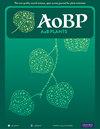Stomatal behavior and water relations in ferns and lycophytes across habits and habitats
IF 2.4
3区 生物学
Q2 ECOLOGY
引用次数: 0
Abstract
Stomatal anatomy and behavior are key to managing gas exchange fluxes, which require coordination with the plant vascular system to adequately supply leaves with water. Stomatal response times and regulation of water loss are generally understudied in ferns, especially across habits (i.e., epiphytic and terrestrial) and habitats (i.e., wet mesic and dry xeric environments). Our objectives were to 1) determine if hydraulic and anatomical traits that control water use are correlated with their habitats (i.e., xeric, mesic) and habits (i.e., epiphytic, terrestrial) for ferns and lycophytes across taxa, and 2) explore how those traits and others like average leaf water residence time correlate with stomatal function using a subset of closely related species. Epiphytic species had lower vein densities than terrestrial species, while xeric species had higher vein densities than mesic species. Xeric ferns also had smaller stomata than mesic ferns, but had similar stomatal densities. Further, in a subset of mesic and xeric ferns, the xeric ferns had higher maximum stomatal conductance and water content, as well as shorter average stomatal opening responses to light intensity, but stomatal closing times did not differ. Finally, shorter stomatal opening and closing responses were correlated with shorter water residence time. Our study highlights anatomical and physiological differences between ferns and lycophytes, which may partially explain habitat preference based on their optimization of light and water.不同习性和生境的蕨类植物和狼尾草的气孔行为和水分关系
气孔的解剖结构和行为是管理气体交换通量的关键,而气体交换通量需要与植物维管系统协调,以便为叶片提供充足的水分。蕨类植物的气孔反应时间和失水调节通常研究不足,尤其是不同习性(如附生和陆生)和栖息地(如潮湿的中性和干燥的干旱环境)的蕨类植物。我们的目标是:1)确定控制水分利用的水力和解剖特征是否与蕨类植物和狼尾草不同类群的栖息地(即干旱、中温)和习性(即附生、陆生)相关;2)利用密切相关的物种子集,探索这些特征以及平均叶片水分停留时间等其他特征与气孔功能的相关性。附生物种的叶脉密度低于陆生物种,而干旱物种的叶脉密度高于中生物种。干旱蕨类植物的气孔也比中生蕨类植物小,但气孔密度相似。此外,在中生蕨类植物和干旱蕨类植物的子集中,干旱蕨类植物的最大气孔导度和含水量更高,对光照强度的平均气孔开放时间更短,但气孔关闭时间没有差异。最后,较短的气孔开闭反应与较短的水分停留时间有关。我们的研究凸显了蕨类植物和狼尾草在解剖学和生理学上的差异,这可能部分解释了蕨类植物和狼尾草基于对光和水的优化而对栖息地的偏好。
本文章由计算机程序翻译,如有差异,请以英文原文为准。
求助全文
约1分钟内获得全文
求助全文
来源期刊

AoB Plants
PLANT SCIENCES-
CiteScore
4.80
自引率
0.00%
发文量
54
审稿时长
20 weeks
期刊介绍:
AoB PLANTS is an open-access, online journal that has been publishing peer-reviewed articles since 2010, with an emphasis on all aspects of environmental and evolutionary plant biology. Published by Oxford University Press, this journal is dedicated to rapid publication of research articles, reviews, commentaries and short communications. The taxonomic scope of the journal spans the full gamut of vascular and non-vascular plants, as well as other taxa that impact these organisms. AoB PLANTS provides a fast-track pathway for publishing high-quality research in an open-access environment, where papers are available online to anyone, anywhere free of charge.
 求助内容:
求助内容: 应助结果提醒方式:
应助结果提醒方式:


